Introduction: The Rise of Band Training in Men’s Fitness
In the ever-evolving world of fitness, versatility and functionality have become the new gold standards for effective training. Among the many modalities gaining traction in modern strength routines, resistance band exercises have emerged as a formidable tool—especially for men seeking scalable, portable, and effective strength solutions. Band workouts for men offer a unique blend of muscular tension, joint-friendly resistance, and full-body engagement that can rival even the heaviest of iron plates. With the rise in functional fitness trends, home-based workouts, and athletic conditioning, resistance bands have cemented their place as more than just a warm-up accessory—they are now foundational to comprehensive strength training regimens.
This article explores the mechanics, benefits, and science-backed effectiveness of resistance band training for men. Whether you’re an experienced weightlifter looking to enhance muscle symmetry or a beginner building strength from scratch, band workouts can provide the challenge and variety your muscles crave. Unlike free weights that rely on gravity, bands create variable resistance through the full range of motion, making every rep count and every set a strategic step toward improved performance. Over the next several sections, we will dive deep into how men can master resistance band workouts to develop total-body strength, increase mobility, and prevent injuries, all while staying aligned with evidence-based fitness principles.
You may also like: The Ultimate 30-Day Workout Plan for Men Working Out in the Gym: Proven Full Body Strength Exercises to Maximize Results
Understanding the Mechanics Behind Resistance Band Training for Men
To fully appreciate the potential of resistance band workouts, it’s essential to understand the science that underpins their effectiveness. Resistance bands operate on the principle of elastic tension, which means the farther you stretch the band, the greater the resistance it provides. This variable resistance contrasts with free weights, where the load remains constant throughout the movement. For men seeking strength development, this difference can lead to superior muscular activation, particularly in stabilizing muscles and end-range contractions.
Resistance band training for men challenges both concentric and eccentric phases of movement. During traditional lifting, gravity assists during the lowering phase, often reducing muscle engagement. However, bands maintain tension throughout both phases, encouraging a slower, more controlled movement pattern that fosters hypertrophy and motor control. Additionally, bands promote greater neuromuscular coordination by demanding continuous stabilization—especially in unilateral movements like single-arm rows or lunges.
What makes bands even more beneficial is their ability to adapt to various strength levels and goals. Whether a man is recovering from injury, aiming to build lean muscle mass, or trying to break through a plateau, resistance bands can be customized to match the required intensity. Different bands offer varying levels of resistance, making them ideal for progressive overload—an essential principle of muscle growth. This adjustability empowers users to target specific muscle groups while minimizing the joint strain often associated with heavy lifting.
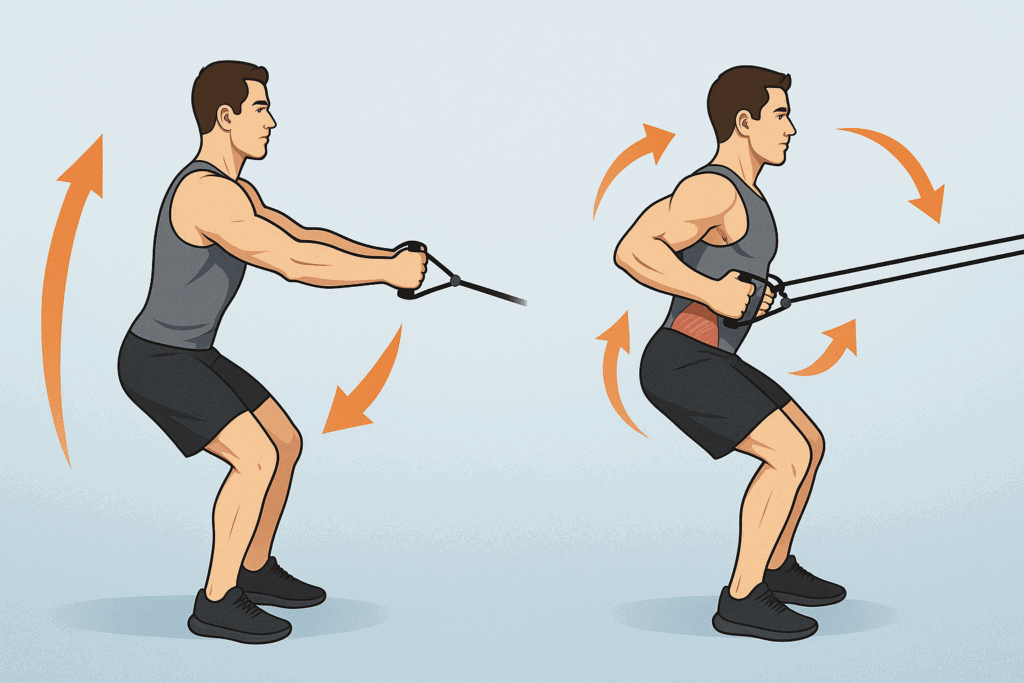
Why Band Workouts for Men Offer a Functional Advantage
Functional fitness is more than just a buzzword—it’s a philosophy centered on improving strength and movement quality for real-life activities. Band workouts for men align perfectly with this concept because they emphasize compound, multi-planar movements that translate into better athletic performance, everyday strength, and injury resilience. Unlike machine-based training that isolates muscles, band exercises recruit multiple muscle groups simultaneously, fostering coordination, core activation, and postural alignment.
For instance, performing band-resisted push-ups doesn’t just activate the chest and triceps; it also forces the scapular stabilizers and core muscles to engage, resulting in more integrated strength. Similarly, lateral band walks train the often-overlooked hip abductors, which play a critical role in knee stability, running efficiency, and injury prevention. The ability of bands to create tension in different planes of motion—horizontal, vertical, diagonal—also helps in replicating the unpredictable nature of sport and life movements.
Moreover, band training is uniquely suited for men with mobility restrictions or prior injuries. The elastic resistance allows for controlled joint loading, which is crucial for maintaining joint health and range of motion. Movements such as band-assisted squats or presses can serve as effective regressions or preparatory drills before advancing to heavier compound lifts. For aging athletes or those returning from rehab, band workouts offer a joint-safe pathway back to functional strength and mobility.
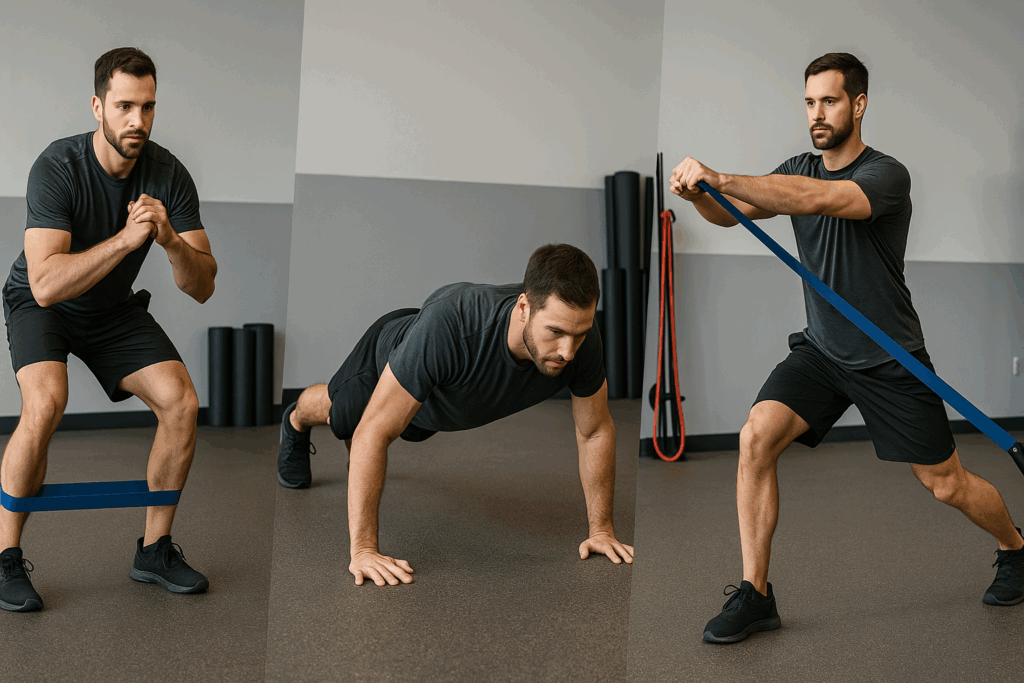
Designing an Effective Resistance Band Training Program for Men
Creating a well-rounded resistance band training program for men requires more than stringing together random exercises. A strategic approach includes movement pattern variety, progressive overload, and deliberate rest and recovery periods. To develop total-body strength, men should target all major muscle groups across multiple planes of motion—pushing, pulling, squatting, hinging, and rotating. Each session should include a balance of upper-body, lower-body, and core-focused exercises to ensure symmetry and avoid muscular imbalances.
A sample weekly program might include upper-body strength on Mondays, lower-body resistance on Wednesdays, and full-body power or endurance circuits on Fridays. Within each session, exercise order should move from compound movements to isolated drills, with appropriate band resistance levels to match fatigue thresholds. For example, pairing band pull-aparts with overhead presses can activate stabilizers before loading primary movers, enhancing both safety and performance.
Progressive overload remains a foundational principle. To avoid plateaus, men should increase band resistance over time, perform more repetitions or sets, or reduce rest intervals between exercises. Periodic variation in tempo—such as slowing down the eccentric phase or incorporating pauses at peak contraction—can also stimulate continued gains. It’s equally important to prioritize proper form and full range of motion over excessive tension. Bands should challenge the muscles without compromising alignment or technique.
Recovery is often overlooked in resistance band training due to the perception that bands are less intense than weights. However, the sustained tension can generate significant metabolic stress, especially in high-rep circuits. Men should allow for adequate rest between sessions, integrate mobility work, and monitor signs of overtraining. Deload weeks—periods of reduced volume or intensity—can be built into the program to support long-term adaptation and joint health.
Top Upper Body Band Workouts for Men to Build Functional Strength
Upper body development is a central goal for many men, and resistance bands offer an effective, joint-friendly solution for enhancing muscular strength, endurance, and control. Unlike traditional weights that require access to benches and racks, band-based workouts can be performed virtually anywhere, using door anchors, poles, or bodyweight leverage. This accessibility makes them ideal for both home gyms and on-the-go training.
One of the most effective upper body movements is the band-resisted row, which targets the lats, rhomboids, and rear deltoids while promoting scapular stability—a key component of shoulder health. To perform this exercise, attach the band to a secure anchor, step back until there’s tension, and pull with controlled motion while keeping elbows close to the body. Varying the grip (overhand, underhand, neutral) can emphasize different regions of the back and arms.
Band push-ups are another powerhouse move, adding resistance to a bodyweight staple and enhancing pec, deltoid, and tricep activation. Loop the band across your back and under your palms, then lower and press with slow, deliberate control. This variation is excellent for men aiming to build explosive pushing power without overloading the shoulder joints.
Shoulder mobility and stability can be addressed through band pull-aparts and overhead presses. Pull-aparts work the often-neglected posterior deltoids and mid-back, improving posture and counteracting the effects of desk-bound lifestyles. Overhead presses with bands require constant stabilization, recruiting core and scapular muscles to maintain alignment. The ascending resistance curve challenges the triceps and delts at lockout, where traditional dumbbell presses tend to lose intensity.

Building Lower Body Power with Resistance Band Training for Men
When it comes to lower body training, many men default to barbells and machines for squats, deadlifts, and lunges. However, resistance band training for men can be equally effective at building strength, stability, and functional power in the legs and glutes, with less joint stress and more versatility. Bands offer a unique training advantage by allowing users to work through a full range of motion with variable tension, encouraging better neuromuscular control and deeper engagement of stabilizing muscles.
A foundational lower body move is the banded squat. Wrapping the band around the shoulders or holding it at shoulder height while stepping on it provides resistance during both the descent and ascent, challenging the quadriceps, hamstrings, and glutes. Unlike barbell squats that place compressive load on the spine, banded squats promote a more upright torso and reduce spinal loading, making them ideal for those with back concerns or limited access to equipment.
Lateral band walks are another key exercise, particularly for targeting the hip abductors and external rotators. These smaller muscle groups play a vital role in stabilizing the knees and pelvis during dynamic movements like running, jumping, or pivoting. To perform this movement, place a loop band around the thighs or ankles, maintain a partial squat, and take controlled steps to the side. The burn is immediate, and the benefits extend to improved agility, balance, and joint protection.
Deadlifts with bands can also replicate the benefits of their weighted counterpart while minimizing risk. Step on the band with feet shoulder-width apart, grip both ends, and stand up by driving through the hips and squeezing the glutes. The resistance increases as you rise, mirroring the natural strength curve of the hips and hamstrings. This makes banded deadlifts excellent for posterior chain development without the need for heavy barbells or gym equipment.
For added intensity, men can incorporate plyometric band exercises like resisted jump squats or banded lunges. These variations not only enhance muscular endurance and power but also improve cardiovascular conditioning. When programmed correctly, lower body band workouts can form the cornerstone of a powerful and athletic physique.
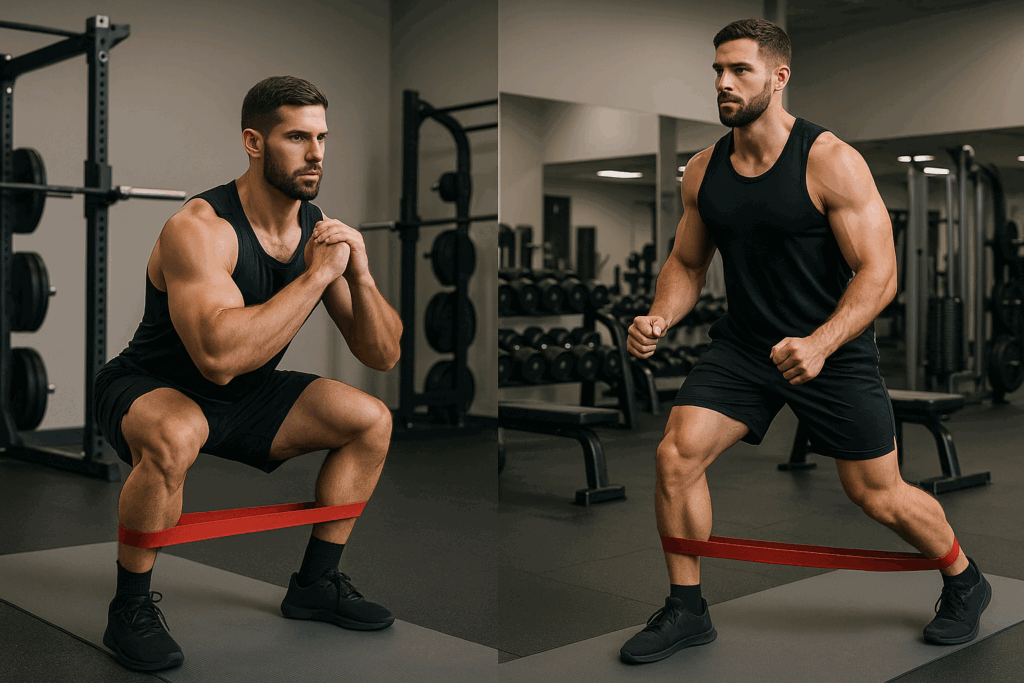
Core Stability and Control Through Band Workouts for Men
Core training is often misunderstood as merely developing visible abdominal muscles, but true core strength involves the coordinated function of deep stabilizing muscles, including the transverse abdominis, obliques, multifidus, and pelvic floor. Resistance bands provide an ideal means to activate and challenge these muscles through dynamic, anti-rotational, and isometric exercises that simulate real-life demands.
One of the most effective band exercises for the core is the Pallof press. Anchoring the band at chest height and pressing it straight out in front of you while resisting rotation works the deep core muscles in ways crunches and sit-ups cannot. This move is especially beneficial for men engaged in sports or physically demanding jobs that require rotational control and spinal stability.
Another powerful core movement is the band-resisted plank row. In this exercise, the band is looped around a stable object, and from a plank position, you perform rows with one arm while maintaining core engagement and a neutral spine. This targets the obliques, rectus abdominis, and deep stabilizers simultaneously, reinforcing shoulder stability and core integrity under tension.
Band chops and lifts—diagonal movements across the body—activate both upper and lower core regions, promoting coordinated control between the trunk and hips. These are excellent for improving rotational power, especially in activities such as golf, baseball, or martial arts. They also enhance movement patterns necessary for safe lifting and twisting motions in daily life.
Additionally, integrating band resistance into traditional exercises like leg raises or Russian twists can provide added stimulus and progression. The continuous tension challenges the muscles throughout the entire range of motion and limits momentum, encouraging precise, controlled movements. For men looking to develop not only aesthetics but also function and injury resilience, core band training is indispensable.
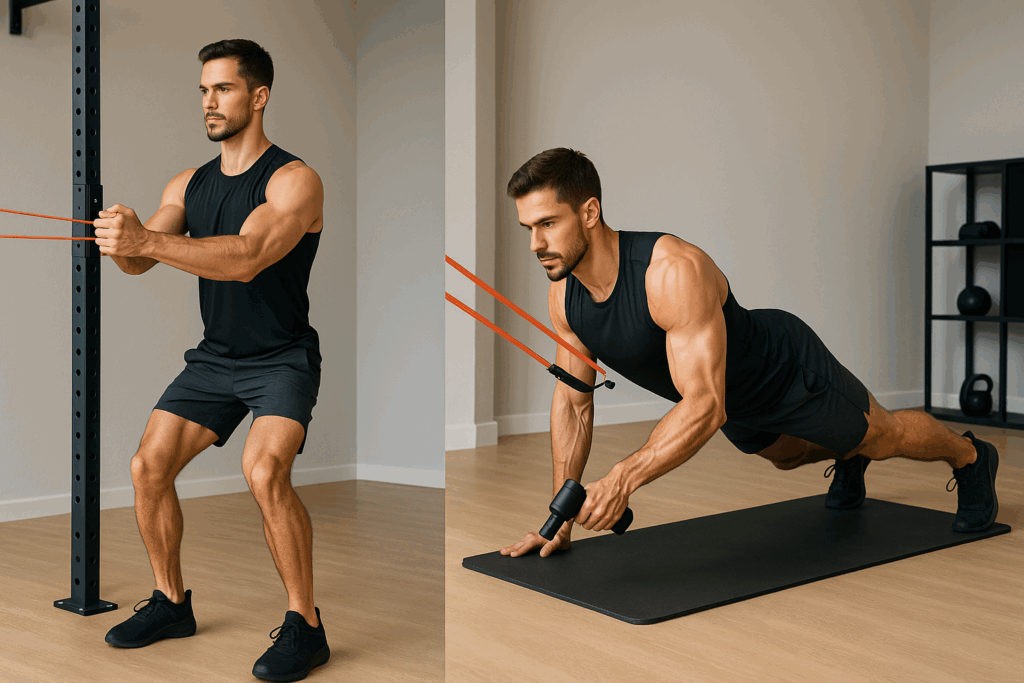
The Science-Backed Benefits of Resistance Band Training for Men
The appeal of resistance band training extends beyond convenience and versatility—it is deeply rooted in exercise science. Multiple studies have confirmed that resistance bands can stimulate muscle activation levels comparable to, and in some cases exceeding, free weight exercises. This is especially true for the smaller stabilizing muscles and end-range contractions that are often neglected in traditional training.
Research published in the Journal of Strength and Conditioning Research has shown that resistance band exercises can significantly enhance neuromuscular control and joint proprioception. This makes them ideal not only for strength development but also for rehabilitation and prehabilitation. Men who integrate band training into their routines often experience improved joint function, enhanced coordination, and reduced injury risk.
Bands also allow for blood flow restriction (BFR) techniques, where lower resistance is used to achieve hypertrophy similar to high-load training. This can be beneficial for men recovering from injuries or seeking muscle growth with less strain on tendons and joints. Additionally, the portability of bands removes barriers to consistency—a key factor in long-term fitness success. When travel, time constraints, or gym access becomes an issue, resistance bands ensure training can continue without interruption.
Another advantage lies in metabolic conditioning. High-repetition band circuits with minimal rest can elevate heart rate, boost endurance, and enhance calorie burn—all while reinforcing muscular tone. For men aiming to stay lean while building strength, this dual benefit can be a game-changer. Moreover, the psychological benefit of mastering new movement patterns and progressing through different resistance levels fosters motivation and long-term adherence.
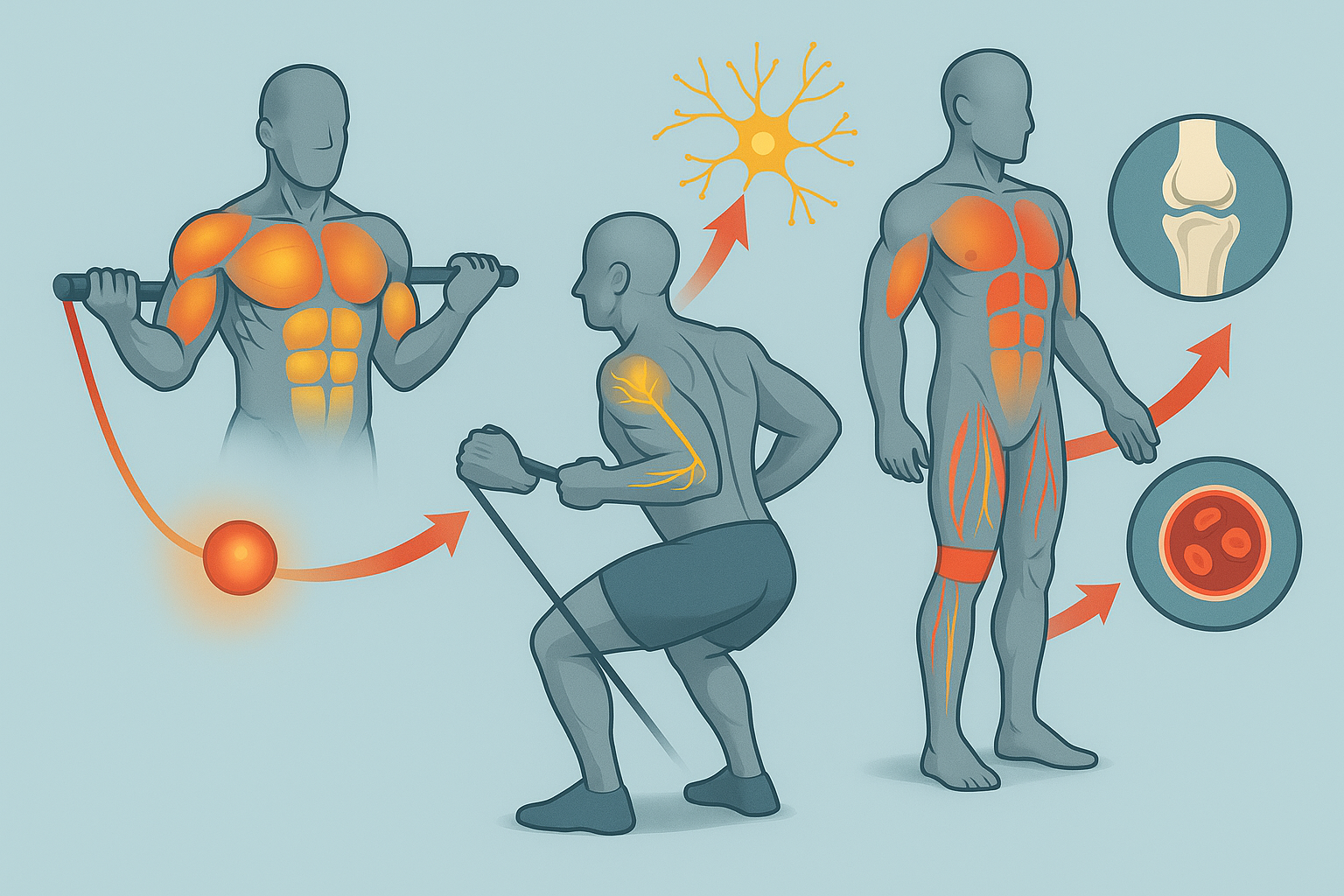
Advanced Strategies to Maximize Results from Band Workouts for Men
To elevate the effectiveness of band workouts, men can incorporate advanced strategies that amplify tension, muscular engagement, and recovery. One such strategy is mechanical drop sets—starting with a more difficult band variation and transitioning to an easier one within the same set. For example, performing band-resisted push-ups until failure and then continuing with bodyweight push-ups extends the time under tension and maximizes hypertrophy.
Another method is tempo manipulation. Slowing down the eccentric (lengthening) phase of a movement to three or five seconds increases muscle damage and metabolic stress, stimulating greater adaptation. This technique is particularly useful in exercises like squats, presses, and rows. Adding isometric holds at the peak contraction point—for instance, holding the top position of a band pull-apart—can further enhance muscle recruitment and mental focus.
Supersetting complementary movements is another powerful tool. Combining a push movement (like a band chest press) with a pull movement (such as a band row) allows for continuous training with minimal rest, improving muscular endurance and cardiovascular output. This structure also balances agonist and antagonist muscle groups, supporting joint health and posture.
Periodization is crucial in long-term band training. Just like with weightlifting, varying intensity, volume, and exercise selection over time ensures continued progress and injury prevention. A well-rounded plan might include strength phases with heavy resistance, endurance phases with high reps and short rest, and deload weeks focused on mobility and technique. Logging workouts, tracking performance, and periodically assessing progress helps maintain focus and momentum.
Recovery strategies should not be neglected. Foam rolling, stretching, hydration, and adequate sleep are essential to support the physical demands of resistance band training. Incorporating active recovery days with light band mobility work can aid in circulation and tissue repair, keeping the body primed for future sessions.

Equipment Essentials and Safety Tips for Resistance Band Training
Getting started with resistance band training requires minimal investment but thoughtful selection. Bands come in several types, including loop bands, tube bands with handles, therapy bands, and figure-eight bands. For men focusing on strength and hypertrophy, loop bands and tube bands are generally the most versatile. It’s helpful to have a range of resistance levels—from light to heavy—to accommodate different muscle groups and progression stages.
Proper setup is key to safety and effectiveness. Anchoring the band securely—whether around a door, post, or heavy object—prevents slipping or snapping during exercise. Inspecting the band regularly for signs of wear, such as cracks or thinning areas, helps avoid accidents. Wearing eye protection when using high-resistance bands is also a smart precaution, especially when bands are anchored above shoulder height.
Form and control should always take precedence over tension level. Unlike weights that provide predictable resistance, bands can accelerate quickly if control is lost. Slow, deliberate movements not only enhance muscular engagement but also minimize risk of strain or injury. Warm-up routines should include dynamic stretches and low-resistance band activation drills to prepare the joints and muscles for higher-intensity work.
Incorporating bands into a broader training regimen also requires awareness of volume and fatigue. Just because bands feel different from dumbbells doesn’t mean they’re less taxing. Monitoring muscle soreness, joint discomfort, and recovery status ensures that training intensity remains within safe limits. When in doubt, working with a certified fitness professional can provide guidance on form, programming, and progression.
Frequently Asked Questions About Resistance Band Training for Men
1. How can resistance band training for men enhance mental discipline and focus?
While physical benefits are often the focal point of resistance band training for men, the mental rewards are equally valuable. Band training requires a high degree of control, patience, and form precision, especially when performing exercises that involve stabilization or unilateral movement. This level of attentiveness naturally cultivates mental discipline, encouraging a mind-muscle connection that sharpens focus. Over time, this mindful approach to movement can translate into other areas of life, improving stress management and resilience. Additionally, setting incremental goals with band workouts—like increasing resistance or improving technique—helps men build a habit of goal-setting and perseverance that strengthens psychological as well as physical grit.
2. What are some overlooked performance benefits of band workouts for men?
Beyond muscle growth and mobility, band workouts for men offer nuanced performance benefits that often go unnoticed. One such benefit is enhanced deceleration control, which is vital in sports like basketball or football where abrupt stops are common. Resistance bands condition the eccentric phase of movement, improving the body’s ability to absorb force safely. Another key benefit is increased intramuscular coordination; because bands demand steady tension and alignment, they train muscles to fire in harmony rather than in isolation. This synergy boosts functional performance across athletic and everyday tasks. Lastly, bands help improve tendon and ligament resilience, which is critical for preventing overuse injuries that often go unaddressed in traditional strength training.
3. How do band workouts for men influence long-term joint health?
Long-term joint health is a cornerstone of sustainable fitness, and resistance bands provide a joint-conscious alternative to heavy lifting. Band resistance grows as the band stretches, naturally matching the strength curve of a joint—less stress at the weakest range and more resistance where the joint is strongest. This feature reduces compressive forces and mitigates injury risks, especially in vulnerable joints like shoulders, knees, and elbows. Over time, consistent use of bands in compound and mobility exercises improves synovial fluid circulation and strengthens surrounding connective tissues. For aging men or those with prior joint issues, this makes band workouts a low-impact, high-reward solution for preserving joint function well into later decades of life.
4. Can resistance band training for men be effectively combined with other training modalities?
Absolutely. Resistance band training for men can complement nearly any training modality, including barbell strength programs, high-intensity interval training (HIIT), bodyweight calisthenics, and even endurance sports. Bands can be used for activation drills before heavy lifting, adding resistance to sprint intervals, or incorporating into plyometric training for power development. In rehab settings, they are often paired with proprioceptive or mobility work to facilitate controlled recovery. What makes bands especially useful in hybrid routines is their adaptability—they can intensify a movement without requiring a change in environment or equipment. This allows men to tailor their training to evolving goals, whether that’s building power, improving speed, or enhancing muscular endurance.
5. What role do band workouts play in preventing training plateaus?
Band workouts for men play a pivotal role in busting through training plateaus by offering a novel stimulus. Because bands apply variable resistance, they challenge the muscles in ways that static loads cannot—particularly at end ranges where muscles are typically underloaded with free weights. Introducing band resistance alters joint mechanics and neuromuscular firing patterns, which can re-ignite progress when gains have stalled. Additionally, bands allow for creative progression strategies like mechanical drop sets, tempo variations, and resistance stacking with weights. This diversity keeps the central nervous system engaged, encouraging continuous adaptation and staving off both physical and psychological stagnation. As a result, bands aren’t just a tool—they’re a strategic asset for any long-term training program.
6. How do resistance band workouts affect hormonal responses in men?
While resistance band workouts are often viewed as lower intensity compared to traditional lifting, they still stimulate a significant hormonal response when programmed correctly. Performing high-volume band circuits with minimal rest can elevate testosterone and growth hormone levels, particularly when compound movements like band squats, rows, and presses are used. The metabolic stress generated by continuous tension contributes to these anabolic effects. Moreover, band training reduces cortisol spikes that are common with high-load barbell training, offering a more balanced hormonal profile—especially for men over 40. When combined with proper nutrition and recovery, resistance band training for men can thus support both muscle maintenance and overall hormonal health.
7. What innovations are emerging in the field of resistance band training for men?
The landscape of resistance band training for men is evolving rapidly, driven by innovations in material design, tech integration, and program delivery. Modern bands now incorporate latex blends with greater durability, textured grips for stability, and modular systems that allow resistance customization. Some advanced setups include digital sensors that track tension, rep speed, and volume, integrating with mobile apps for real-time feedback. There’s also a surge in virtual coaching platforms specifically built around band-based programs, offering tailored progressions and community support. These innovations are making band training more accessible, data-driven, and performance-focused, offering men more tools than ever to pursue strength goals with intelligence and precision.
8. How can band workouts for men support post-injury rehabilitation?
Band workouts for men are highly effective for injury rehabilitation due to their low-impact nature and adjustable resistance. After injury, regaining range of motion and reactivating stabilizer muscles without overloading joints is crucial. Bands allow for targeted movement patterns that can be scaled from assisted to resisted work, making them ideal for all phases of rehab. They’re especially useful in reconditioning the rotator cuff, hips, and knees, where proprioceptive and eccentric control is vital. Furthermore, resistance band training for men can bridge the gap between physical therapy and return-to-sport readiness by providing functional movement patterns under safe loading conditions. This makes them indispensable for athletes and recreational lifters alike recovering from strain, surgery, or chronic conditions.
9. What psychological advantages are associated with consistent band training?
Consistency in any fitness regimen yields mental health benefits, and resistance band training is no exception. The portability and ease of use associated with bands remove many barriers to training adherence, fostering routine and discipline. Regular band workouts for men can lead to improved self-efficacy, particularly as users gain confidence in mastering control and form without needing elaborate setups. Additionally, the reduced risk of injury lowers anxiety around training, encouraging experimentation and sustained engagement. There’s also a mindfulness component—because bands demand focus on tempo, alignment, and muscle engagement, they naturally cultivate a meditative, immersive experience. For men balancing stressful careers and personal obligations, this mental release can be as valuable as the physical gains.
10. How can beginners approach resistance band training for men without feeling overwhelmed?
Beginners often find the gym environment intimidating, but resistance band training for men provides a non-threatening entry point that emphasizes control, safety, and adaptability. Starting with foundational movement patterns—such as squats, rows, and presses—allows men to build proprioception and learn movement mechanics before introducing higher tension or complex routines. Bands can be anchored at various heights and positions to accommodate different strength levels and mobility restrictions, creating an inclusive experience for all fitness stages. Incorporating structured beginner programs or virtual guidance ensures progression without overload. Over time, this self-paced, accessible approach builds both competence and confidence, turning what might seem like a simple piece of equipment into a lifelong fitness companion.
Conclusion: Unlocking Strength and Longevity with Band Workouts for Men
Resistance band training represents more than a convenient alternative to traditional weights—it is a scientifically validated, functionally rich, and remarkably adaptable method for building strength, resilience, and longevity. As explored throughout this article, band workouts for men offer unique advantages that extend beyond muscle hypertrophy. They cultivate joint health, support neuromuscular coordination, and integrate easily into any fitness environment—from home gyms to elite performance centers.
Whether the goal is to develop athletic power, rehabilitate from injury, or simply maintain strength into older age, resistance band training for men provides a sustainable, effective pathway. By strategically programming upper body, lower body, and core movements; by embracing principles like progressive overload and tempo manipulation; and by respecting the body’s need for recovery and adaptation, men can unlock their full physical potential with minimal equipment and maximum impact.
The simplicity of a resistance band belies its power. For the man seeking durability, flexibility, and enduring strength, embracing band workouts is not just a trend—it’s a transformative shift toward smarter, more sustainable training. In a world saturated with fitness fads and overcomplicated routines, the timeless effectiveness of bands stands out. It’s time to stretch, pull, and press your way to a stronger, more capable you.
Further Reading:
Add the best resistance band exercises for every body part to your workouts





